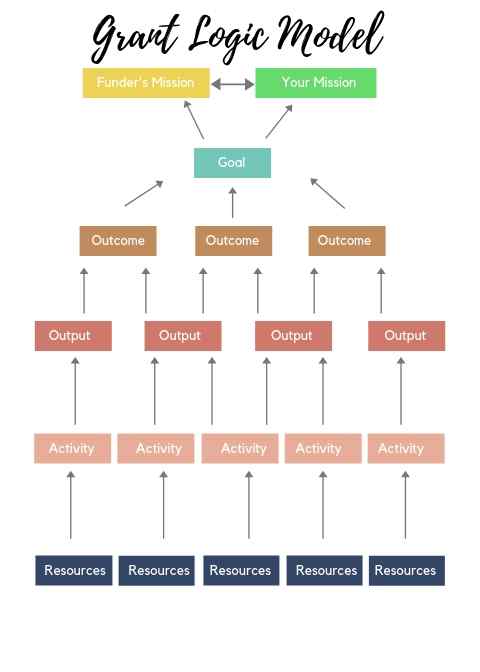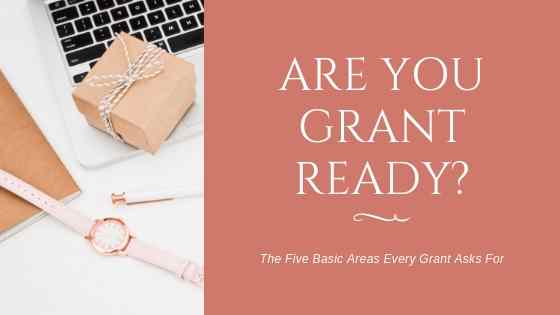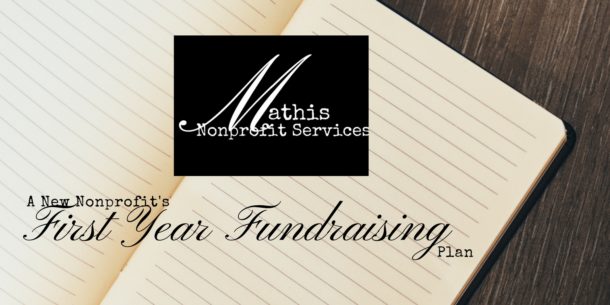Are you grant ready? You’ve probably heard the term “grant ready” before. If you aren’t sure what it means, it simply refers to having everything your organization needs to write and receive a grant that gets funded. In this article, we’ll discuss the basic areas of grants, how you can clearly define these areas, and you’ll have an opportunity to go deeper.
Grants have five basic areas that you need to be crystal clear on in order to write a competitive grant. They are Issue Statement, Intended Outcomes, Methods, Evaluation, and Budget.
Issue Statement
Issue statement is also called the need, problem or community need statement. To be crystal clear on this, you need to understand what specific need, issue, or problem your nonprofit or project will address. Also, write down why it’s important in your community. Knowing the need and why the community needs your solution makes a competitive grant. It may take you asking why five times to get to the basic connection. This basic connection will resonate with most people and often falls somewhere in Maslow’s Hierarchy of Needs.
Intended Outcomes
 Intended outcomes are the specific changes or outcomes you intend to achieve as a direct result of the project. This is where you link action to impact and outcomes. A logic model comes into play here. Working from the bottom of the Logic Model, decide what resources you need to run your program. Think in terms of people/ people’s time, money, equipment, facilities, and supplies. Next, we look at what processes or tasks are used/done with the resources. Moving up the model, what deliverables come from the process? This will be tangible, direct, and immediate results of the resources and processes. Next, we have the benefit or changes for participants or the community as a result of program activities. Last, we get to the overall purpose or goal, the ultimate long-term benefits toward which this program contributes. This is more about the long-term goal of the organization. If you aren’t crystal clear on any of these things in your organization and how they relate, your first step is to figure this out. You can download a logic model template or a program development worksheet to help.
Intended outcomes are the specific changes or outcomes you intend to achieve as a direct result of the project. This is where you link action to impact and outcomes. A logic model comes into play here. Working from the bottom of the Logic Model, decide what resources you need to run your program. Think in terms of people/ people’s time, money, equipment, facilities, and supplies. Next, we look at what processes or tasks are used/done with the resources. Moving up the model, what deliverables come from the process? This will be tangible, direct, and immediate results of the resources and processes. Next, we have the benefit or changes for participants or the community as a result of program activities. Last, we get to the overall purpose or goal, the ultimate long-term benefits toward which this program contributes. This is more about the long-term goal of the organization. If you aren’t crystal clear on any of these things in your organization and how they relate, your first step is to figure this out. You can download a logic model template or a program development worksheet to help.
Methods
Ask yourself what the major steps you will need to take to make these changes happen. What is the timeline? Milestones? Who will be responsible for each step? Where will these things happen? What resources (from the logic model) will be used? Think through all these things and write them out.
Evaluation
Let’s talk evaluation. Simply put how will you measure your success in achieving your objectives? Do not skip this step. I know you may be tempted but this stuff is so important. Your evaluation will be specific to your program and explain how it aligns with the mission of the organization. What activities will be used to evaluate the outcomes and impact? How will you assess these things? It doesn’t have to be complicated. It can be graduation rates or a survey. The key is that you are building measurements into your program that you can look at and evaluate your success.
Budget
Finally, the budget is needed. A budget should take everything needed to complete the project into account. Include staff, equipment, and facilities. Even if you’re getting donated materials and time, price it as if you are paying for the services. Where will the money come from? What other sources do you have available to fund this program?
There you have it. The five basic questions you need to think through to be ready for Grants. Having a clear plan will help you get funded. If you would like to learn more about writing grants, Maryn Boess has a grant class coming up June 17th. It’s not too late to register. Here is the link to get more information. Since I’m an affiliate*, you can receive $100 off if you use this link to register.
*Being an affiliate means I get perks when you buy through my link. I would recommend this class even if I wasn’t an affiliate but this way you get $100 off. Win-Win!


 Most nonprofit leaders lay awake at night trying to figure out how to fund their mission.
Hi! I'm Alesha.
I teach sustainable fundraising in a way that they can take action today so they can serve their clients.
I can help you move from just getting started funding your new nonprofit to gaining confidence in your fundraising and building relationships to knowing what works for your organization and looking at the infinite game when it comes to funding. I’ve worked with nonprofit Founders and written the book I HAVE MY 501(C)3! NOW WHAT?!? Your Blueprint to Starting Your Nonprofit Without Being the Sole Funder that lays the foundations for funding in a new nonprofit.
I’ve worked in Development (Fundraising) Departments in large organizations and I know the no cost, low-cost methods they use to bring in funding. I bring those sound strategies to the nonprofits I serve.
Most nonprofit leaders lay awake at night trying to figure out how to fund their mission.
Hi! I'm Alesha.
I teach sustainable fundraising in a way that they can take action today so they can serve their clients.
I can help you move from just getting started funding your new nonprofit to gaining confidence in your fundraising and building relationships to knowing what works for your organization and looking at the infinite game when it comes to funding. I’ve worked with nonprofit Founders and written the book I HAVE MY 501(C)3! NOW WHAT?!? Your Blueprint to Starting Your Nonprofit Without Being the Sole Funder that lays the foundations for funding in a new nonprofit.
I’ve worked in Development (Fundraising) Departments in large organizations and I know the no cost, low-cost methods they use to bring in funding. I bring those sound strategies to the nonprofits I serve.